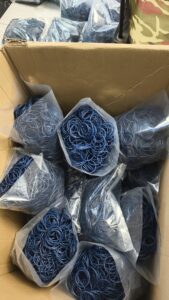Table of Contents
ToggleWhat is an O-Ring for a Car?
An O-ring is a small, doughnut-shaped sealing component critical to preventing leaks of fluids or gases in automotive systems. Made from elastomers like rubber or synthetic polymers, O-rings are compressed between mating parts to create a reliable seal under varying pressures, temperatures, and chemical exposures. This article explores their design, materials, applications, and best practices for ensuring longevity in vehicles.


1. Basics of O-Ring Design and Function
Structure and Sealing Mechanism
- Shape: A toroidal (circular cross-section) ring that fits into a groove between two components.
- Working Principle:
- When compressed, the O-ring deforms to fill the gap, creating a contact pressure that blocks leakage.
- Under system pressure, the O-ring is forced against the groove walls, enhancing the seal’s effectiveness.
Static vs. Dynamic Seals
- Static Seals: Used where no relative motion occurs (e.g., engine valve covers, coolant housings).
- Dynamic Seals: Employed in moving parts (e.g., hydraulic pistons, steering pump shafts).
2. Common Automotive Applications
O-rings are integral to nearly every fluid or gas system in a car:
- Engine Systems:
- Valve stem seals (prevent oil from entering combustion chambers).
- Crankshaft and camshaft seals (retain engine oil).
- Fuel System:
- Fuel injector O-rings (seal high-pressure fuel lines).
- Fuel pump connections (resist gasoline or diesel exposure).
- Transmission and Drivetrain:
- Automatic transmission fluid (ATF) seals.
- Differential housing gaskets.
- Cooling System:
- Radiator hose connectors.
- Water pump and thermostat housing seals.
- Braking System:
- Hydraulic brake line O-rings (withstand brake fluid and pressure).
- Air Conditioning:
- Refrigerant line seals (prevent gas leaks in AC systems).
3. Material Selection for Automotive O-Rings
Material choice depends on operating conditions such as temperature, pressure, and chemical exposure:
Key Materials
- Nitrile Rubber (NBR):
- Pros: Cost-effective, excellent oil/fuel resistance.
- Cons: Limited to temperatures between -30°C to +100°C.
- Applications: Fuel lines, oil systems.
- Fluorocarbon (FKM/Viton®):
- Pros: Withstands -20°C to +250°C, resists aggressive chemicals and oils.
- Applications: Turbocharger seals, engine components.
- Silicone (VMQ):
- Pros: Flexible at -50°C to +230°C, ideal for extreme thermal cycling.
- Applications: Coolant systems, intake manifolds.
- EPDM Rubber:
- Pros: Resistant to water, steam, and coolant.
- Applications: Cooling systems, brake boosters.
Specialized Compounds
- HNBR (Hydrogenated Nitrile): Enhanced heat and chemical resistance for hybrid/electric vehicles.
- Aflas® (TFE/P): For high-temperature electrical components.
4. Standards and Quality Assurance
Automotive O-rings must meet rigorous standards to ensure reliability:
- SAE J200: Classifies elastomers by heat and fluid resistance.
- ISO 3601: Defines dimensional tolerances and testing methods.
- OEM Specifications: Original equipment manufacturers (e.g., Ford, Toyota) often require proprietary material certifications (e.g., Genuine Viton®).
5. Failure Modes and Prevention
Common Causes of Failure
- Thermal Degradation:
- Brittle cracking from prolonged heat exposure (e.g., near exhaust systems).
- Chemical Swelling:
- Material incompatibility (e.g., NBR with biodiesel).
- Compression Set:
- Permanent deformation due to constant pressure (leads to leaks).
- Installation Errors:
- Twisting, over-stretching, or improper lubrication during assembly.
Maintenance Best Practices
- Regular Inspections: Replace O-rings during routine maintenance (e.g., oil changes).
- Proper Lubrication: Use silicone-based grease to ease installation and reduce friction.
- Avoid Reuse: Discard O-rings after disassembly; never reuse damaged ones.
6. OEM vs. Aftermarket O-Rings
- OEM Parts:
- Precisely match original specifications for material, size, and performance.
- Recommended for critical systems (e.g., fuel injectors).
- Aftermarket Options:
- Cost-effective alternatives if they meet SAE/ISO standards.
- Verify compatibility with fluids and temperatures before use.
7. Installation Guidelines
- Groove Design: Ensure proper groove depth and compression (typically 15–25%).
- Tool Usage: Employ O-ring picks or cones to avoid nicks during installation.
- Lubrication: Apply grease compatible with the O-ring material and system fluid.
Conclusion
An O-ring in a car is a deceptively simple yet vital component, ensuring leak-free operation across critical systems. By selecting the right material, adhering to industry standards, and following proper installation practices, automotive O-rings enhance vehicle safety, efficiency, and longevity. Whether in a high-pressure fuel injector or a cooling system hose, these small seals play an outsized role in keeping your car running smoothly.



Leave A Comment